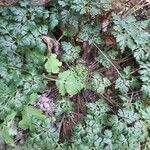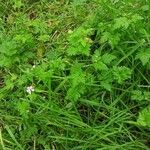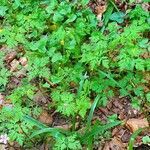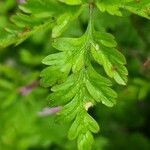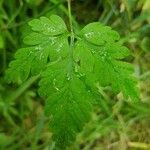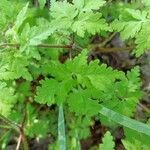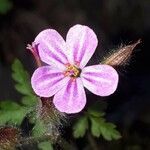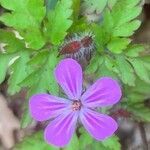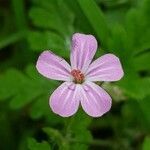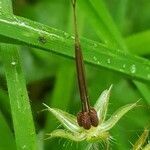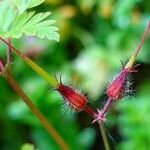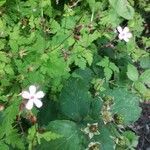Annual or biennial hairy taprooted herb, with a characteristic scent. Stems decumbent to spreading, to c. 50 cm long, lax, often red where exposed to strong light, sometimes with base thickened; internodes short and lvs rosette-like. Petioles long and slender on lower lvs, often reddish, glabrous or hairy. Lamina palmate, to c. 9 × 10 cm, broad-or triangular-ovate, usually becoming red with age; lobes 3-5, at least the terminal petiolulate, pinnately divided to varying degrees, ± appressed-hairy; ultimate segments usually mucronulate. Infl. very diffuse; fls paired; peduncles usually > pedicels; peduncles and pedicels with long-and short-stalked glands. Sepals (at anthesis) 6.5-8 mm long including apical awn, ovate, prominently 3-nerved, with hairs as on pedicels. Petals (7.5)-10-11.5 mm long, obovate-oblanceolate, pink or rose except for white margin of claw; limb = claw; apex rounded. Filaments pinkish; anthers orange. Mericarps 2.5-3 mm long, glabrous or hairy, with 4-6 transverse ridges. Seed smooth.
Weak annual or biennial with branched, spreading, villous or villosulous stems to 6 dm; lvs 3–5-cleft to the base, at least the terminal segment evidently petiolulate, all segments pinnately lobed or cleft; peduncles from most of the upper nodes, mostly 2-fld; sep 7–9 mm, shortly aristate, erect at anthesis; pet 9–13 mm, bright pink or red-purple, entire, long-clawed; carpel-bodies (unlike our other spp.), disarticulating from the beak but tending to remain attached for some time to the stylar column by a pair of elongate, subapical filaments, the proper beak separating from the stylar column ± as in other spp.; 2n=32, 64. Damp rich woods; widespread in the Old World (esp. Eurasia) and widely naturalized in our range. May–Sept. (Robertiella r.)
A herb. It is a sprawling plant. It has an unpleasant smell. It grows 30-40 cm tall. The leaves are dark green and divided like fingers on a hand. They are 6 cm long and have leaflets that are light green with purple edges. The flowers are star shaped and up to 2 cm across. They are dark red. They are usually in pairs near the end of the plant.
